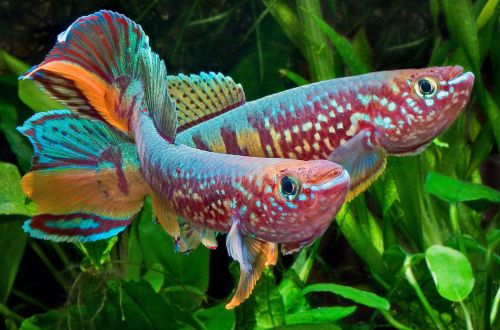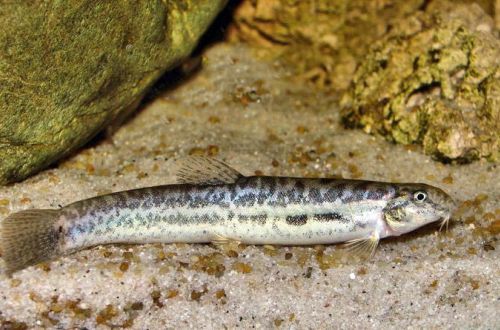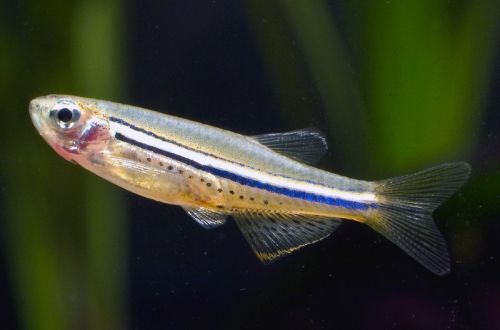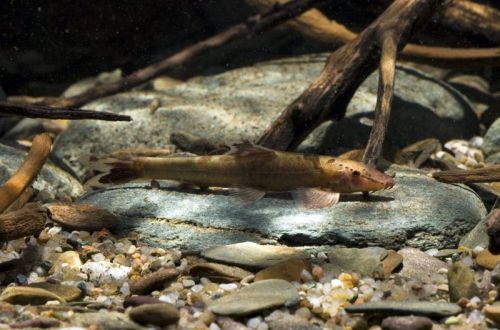
Blue Gularis
Blue Gularis or Blue Fundulopanhax, scientific name Fundulopanchax sjostedti, belongs to the Nothobranchiidae family. A popular and widely available fish. It is distinguished by beautiful coloring, unpretentiousness in maintenance and calm disposition in relation to other species. Great for general freshwater aquariums.

Contents
Habitat
Occurs from the territory of modern Nigeria and Cameroon (Africa). It lives in the swampy coastal part of tropical forests – deltas of rivers and streams, small lakes, the water in which is often brackish due to the proximity of the sea.
Brief information:
- The volume of the aquarium – from 80 liters.
- Temperature – 23-26°C
- Value pH — 6.0–6.5
- Water hardness – soft (1-10 dGH)
- Substrate type – any dark
- Lighting – subdued
- Brackish water is permissible in a concentration of 5 g. of salt per 1 liter of water
- Water movement is weak
- The size of the fish is up to 12 cm.
- Food – meat
- Temperament – peaceful
- Keeping a group in the ratio of one male and 3–4 females
Description
Adults reach a length of about 12 cm. Males are slightly larger than females, brighter in color and have more elongated fins. The color of the body is bluish with a variable dark brown or purple color closer to the head. The fins and tail are decorated with contrasting dots and lines with a wide reddish stripe.
Food
The basis of the diet should consist of frozen or live foods, such as bloodworms, daphnia or brine shrimp. Dry food is rarely used and only as a supplement.
Maintenance and care, arrangement of the aquarium
A group of 3-4 fish will need a tank with a volume of 80 liters or more. The design uses a dark substrate, areas with dense vegetation, including floating on the surface, and several shelters in the form of snags.
When arranging an aquarium, some features of the Blue Gularis should be taken into account, in particular, its tendency to jump out of the water and its inability to live in a fast current. Accordingly, you should take care of the presence of a cover, and equipment (primarily filters) are installed in such a way as to minimize the movement of water.
Otherwise, this is a very unpretentious species that does not require special personal care. To maintain optimal living conditions, it is enough to replace part of the water weekly (15–20% of the volume) with fresh water and regularly clean the soil from organic waste.
Behavior and Compatibility
Calmly relate to representatives of other peace-loving species of similar size. Intraspecific relationships are not so harmonious. Males compete with each other for territory and females, enter into fierce fights, which, however, rarely lead to injuries, however, soon the subdominant male will become an outcast and his fate will be sad. Therefore, in a small aquarium (80-140 liters) it is recommended to keep only one male in the company of 3-4 females. This number of females is not accidental. During the mating season, the male becomes overly active in his courtship and his attention must be dispersed to several partners.
Breeding / breeding
Favorable conditions for spawning are considered to be the establishment of water parameters at the following values: pH not higher than 6.5, dGH from 5 to 10, temperature 23–24°C. At the bottom there is a dense cover of low-growing small-leaved plants or mosses, among which fish lay eggs. The lighting is subdued.
It is worth noting that parental instincts are poorly developed, immediately after spawning (it lasts about a week), it is advisable to place the eggs in a separate tank, otherwise they will be eaten. The fry appear within 21 days, the duration of the incubation period depends on the temperature. At this time, the greatest danger is the appearance of a white coating on the eggs – a pathogenic fungus, if no action is taken, the entire masonry will die.
Fish diseases
Health problems arise only in case of injuries or when kept in unsuitable conditions, which depresses the immune system and, as a result, provokes the occurrence of any disease. In the event of the appearance of the first symptoms, first of all, it is necessary to check the water for the excess of certain indicators or the presence of dangerous concentrations of toxic substances (nitrites, nitrates, ammonium, etc.). If deviations are found, bring all values back to normal and only then proceed with treatment. Read more about symptoms and treatments in the Aquarium Fish Diseases section.





